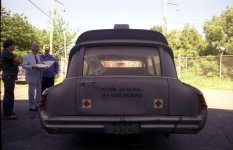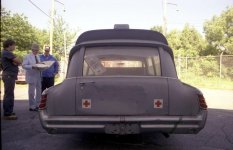yes it is a shame that not one pictures was taken of the data plate with someones ring and finger or ID card in the frame.
but if any one has any pictures to post send them to the moderate. he will post them in the proper spot. it's our policy to only allow site supporters picture posting privileges. as they are paying the way for this site. not the membership of the club.
it was policy for out of service cars to have the ID number painted out. as this was the licence plate of the car. I have always thought that the back door (libary car) had been re lettered as all of it is in the painted (Gray) back ground. but we have a few members that do forensic for a living and they say there the same. having run the pictures threw there tests. but still they could have been, using the same type stencil being put right back over the original lettering when the Medical department was added. we know the BJ car is not lettered correctly. the dots on the U and S never appear on any government car. your surprised on the letters using a retired admirle, figure that one out. how could you make that mistake. to much education. Doc j did not letter the car. a check of the movie has reviled that this is the way Bob K's car which was the one used in the movie was lettered. be interesting to see if the the views on the back interior match up. they almost never do. even sold off a contract they were built different on the line.
but if any one has any pictures to post send them to the moderate. he will post them in the proper spot. it's our policy to only allow site supporters picture posting privileges. as they are paying the way for this site. not the membership of the club.
it was policy for out of service cars to have the ID number painted out. as this was the licence plate of the car. I have always thought that the back door (libary car) had been re lettered as all of it is in the painted (Gray) back ground. but we have a few members that do forensic for a living and they say there the same. having run the pictures threw there tests. but still they could have been, using the same type stencil being put right back over the original lettering when the Medical department was added. we know the BJ car is not lettered correctly. the dots on the U and S never appear on any government car. your surprised on the letters using a retired admirle, figure that one out. how could you make that mistake. to much education. Doc j did not letter the car. a check of the movie has reviled that this is the way Bob K's car which was the one used in the movie was lettered. be interesting to see if the the views on the back interior match up. they almost never do. even sold off a contract they were built different on the line.





